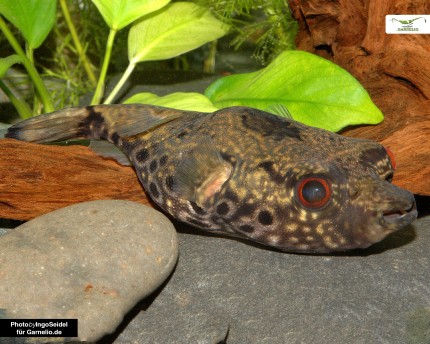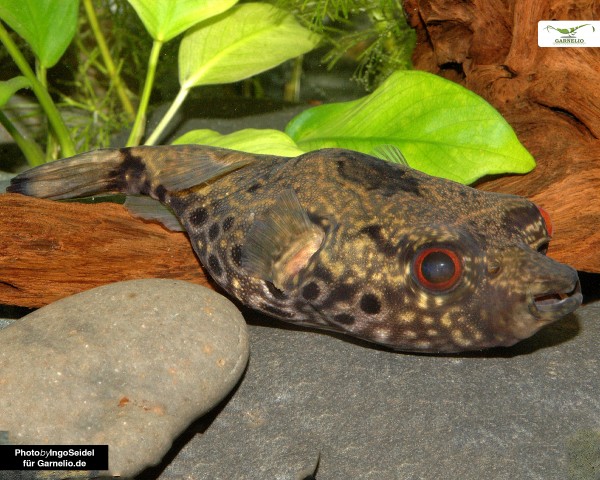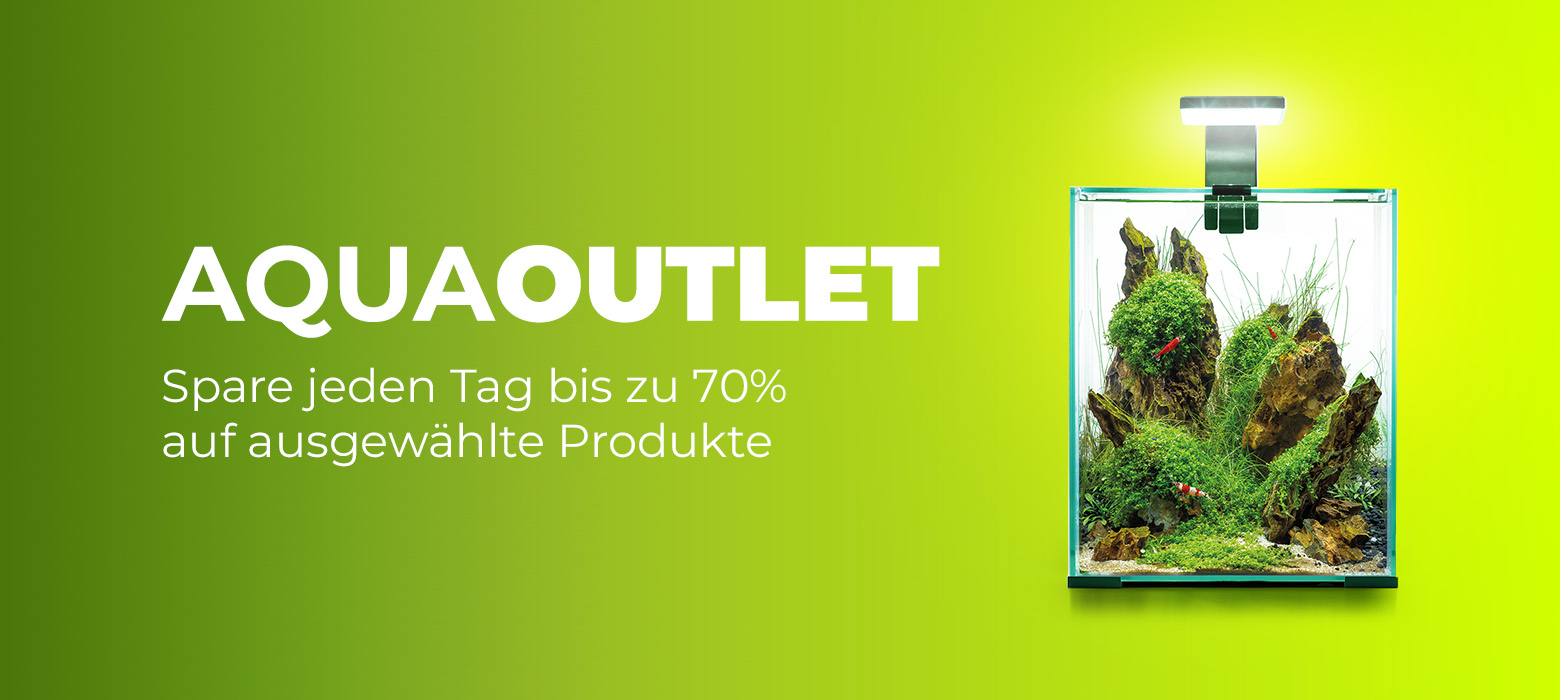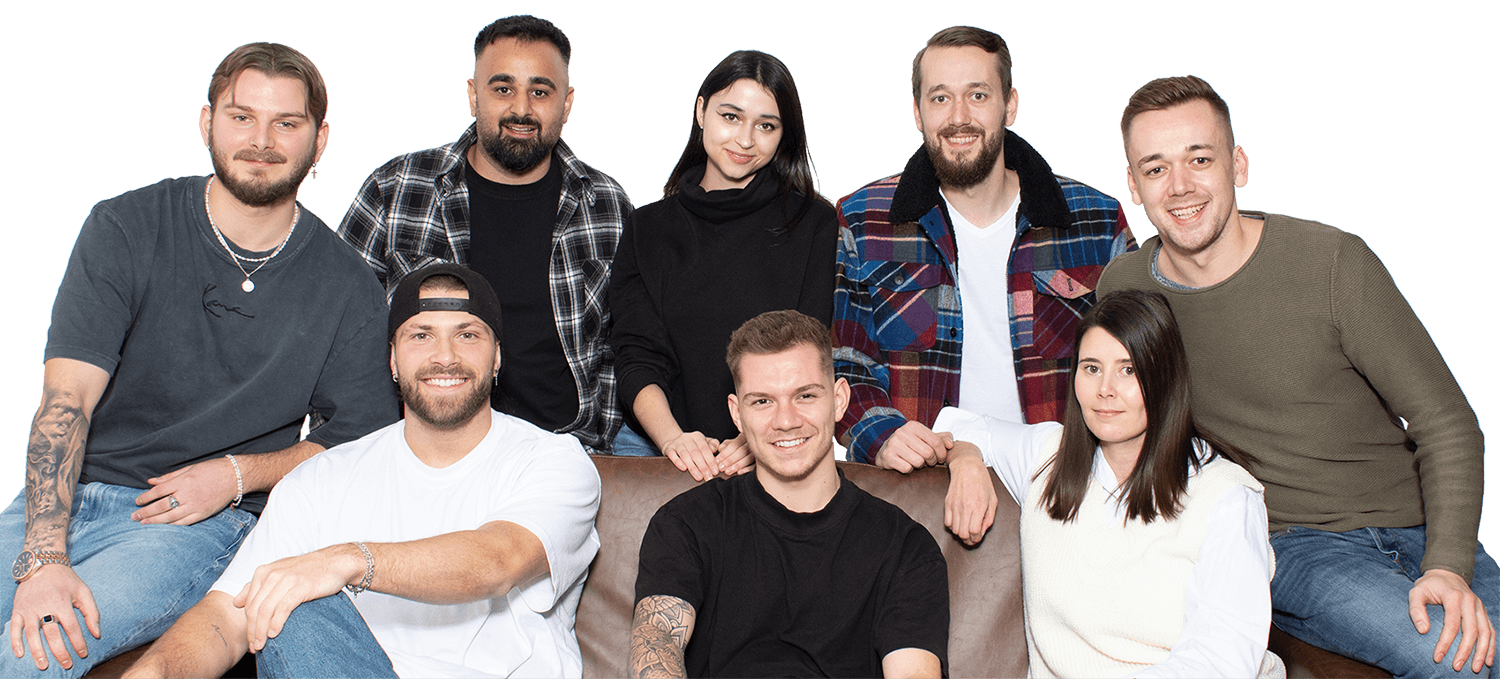incl. VAT plus shipping costs
Currently not available
Delivery only innh. Germany and Austria possible.
Switch to the German store
- Item no: 7887
Fast delivery times
All products are in stock with us!14 years of breeding experience
Let our team of experts advise you!High customer satisfaction
from over 3,000 reviews "| Origin: | Asia |
| Pelvic region: | Center |
| with shrimps?: | Socialization not possible |
| with dwarf crabs?: | No |
| Diet: | molluskivor - snail eater |
| Breeding: | heavy |
| Planting possible?: | Yes |
| Visual effect: | Especially colorful |
| Final size: | > 12cm |
| Aquarium size: | 250/300 l (approx. 120cm) |
| Difficulty: | 4 - Special |
| with snails/shells?: | No |
| Fish group: | Pufferfish |
| Temperature: | 20-25 °C |
Tetraodon palembangensis, the true Palembang pufferfish is another representative of the pure freshwater pufferfishes. It owes its name rather to its original locality near the city of Palembang in southern Indonesia on the island of Sumatra. Other occurrences are also known from West Borneo, where it inhabits pure freshwater habitats with soft and slightly acidic water, which distinguishes it from Tetraodon biocellatus, which is also traded under the name Palembang Pufferfish. The latter can be kept in brackish water.
With a final size of about 20 cm the real Palembang Pufferfish is a medium sized representative of its species. Characteristic is the body shape of the animals, they show a prominent hump and do not appear at first glance as one imagines a classic, round puffer fish. The head is much smaller in relation to the overall size with large, bright red eyes, which the animals can move independently. The basic color of the animals is a slightly bright, light yellow, which is covered with irregular patterns of dark and orange stripes, reticulations and dots. On top of this, dark patterns are giraffe or reticulated across the body. An intricate filigree pattern of orange dotted lines runs across this.
Tetraodon palembangensis feeds in nature exclusively predatory, i.e. from smaller fish, invertebrates (shrimps) and snails, whereby it has actually a pronounced preference for snails and prefers these, beside shrimps to the fish. Thereby it is a lurking hunter, perfectly adapted to the weedy environment with its markings and lying on the bottom waiting for an inattentive fish or shrimp to cross its field of vision. Then the rather quiet fellow comes alive in a flash and grabs the unsuspecting animal.
A socialization with other fish of the same size or larger can be successful, but it always depends on the individual "character" of the kept puffer fish. Here you should study your animals well before you select possible by-fish. Keeping them in pairs is possible, if the tank is big enough ( at least 1,20 m edge length ), but it is rather difficult to distinguish between the sexes. Females should be more reserved in behavior, less intensely colored and less "humpy".
The diet of carnivorous puffer fish should be as varied as possible with Live foodsuch as white mosquito larvae, snails and for larger animals feeding shrimps. Especially snails should be regularly on the menu, because the puffer fish "wear" their teeth on the shell and thus prevent an overbite. If the daily feeding is experimented with, for example, small Frozen food or, for example, small frozen fish are offered with tweezers, the animals can possibly even be switched to frozen food. Feeding snails, which you can purchase in our store, are also suitable.
Since snails should always be available as food, it is recommended to breed them in a separate small tank with minimal equipment to have them permanently available. As food snails would offer themselves particularly post horn snails, which become somewhat larger.
Our food recommendation: The NatureHolic Cichfeed has a grain size of 1.5 mm and is therefore also suitable for larger fish. The NH Cichfeed is a soft granulate for mainly carnivorous fish. It has the same consistency as small crustaceans and insect larvae that fish naturally eat, and the soft granules protect the fish's mouth from micro-injuries that can result from hard feed granules.
Our plant recommendation: Use for planting NatureHolic InVitros. These are free of snails, planarians and other unwanted co-inhabitants. Also free of algae spores, bacteria and fungi.
Expert Tip: We recommend for fish keeping the NatureHolic 3 Phase Liquid. The care set offers the best all-round protection for your animals. It ensures optimal conditions for successful breeding and keeping.
| Scientific name: | Tetraodon biocellatus, Tetraodon steindachneri, Chelonodon biocellatus |
| German Name: | Eye spot pufferfish, palembang pufferfish, figure 8 pufferfish |
| Difficulty level: | advanced |
| Origin/Distribution: | Asia |
| Coloration: | Olive green with golden green pattern |
| Age expectancy | approx. 8 years |
| Water parameters: | GH 5°-20° dGH, KH 2-8° dKH, pH 6.0-7.5, temperature24°-28° C |
| Tank size: | 120 cm and up |
| Food | Carnivorous; live and frozen food, such as mosquito larvae, artemia, daphnia, snails |
| Breeding | possible |
| Behavior | calm, aggressive towards conspecifics and other fish |
| Group size | Single keeping/pairwise |
| Further information | Ten typical aquarium fish for beginners and alternatives to them, Tips for acclimating fish to the aquarium, Feeding aquarium fish properly - cheap food and what it can do, Keeping puffer fish in the aquarium |
- Item no: 7887
Entdecke die Garnelio Welt!
Garnelio gehört zu den größten Onlineshops für wirbellose Aquarientiere weltweit.
Viele Artikel gibt es exklusiv nur bei uns im Shop.











